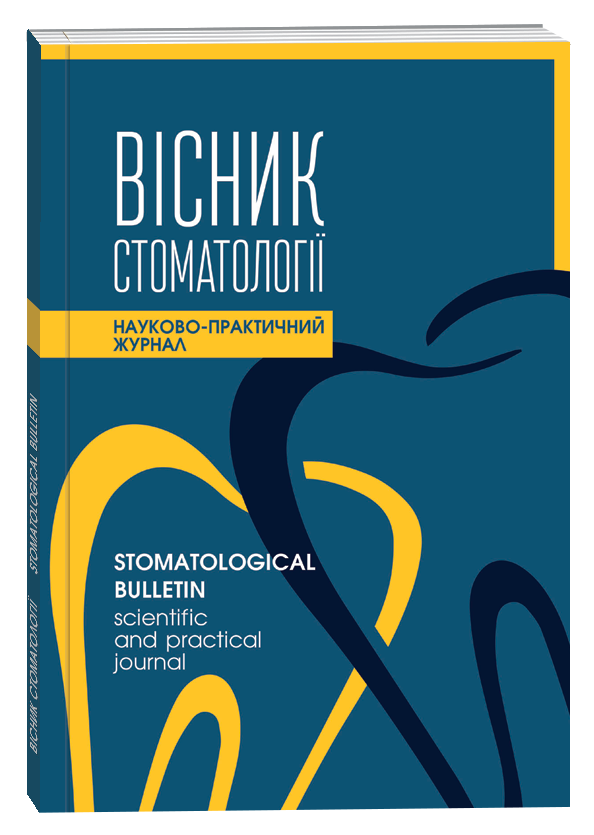PREVALENCE AND STRUCTURE OF DENTOGNATHIC ANOMALIES IN CHILDREN AND ADOLESCENTS OF TRANSCARPATHIAN REGIONAL CENTERS
DOI:
https://doi.org/10.35220/2078-8916-2019-33-3-38-42Keywords:
children, prevalence, dentognathic anomalies, biteAbstract
The aim of the study to determine the prevalence and structure of dentognathic anomalies and the need for or-thodontic treatment in children and adolescents of the Transcarpathian regional centers.
Materials and Methods. The objects of the survey were children aged 8-15 years’ old who study in general edu-cational institutions. The examination of children and ad-olescents was conducted in three age groups: 8-10 years – the period of changing bite; 11-13 years – the period of formation of constant bite; 14-15 years – a period of con-stant bite. Were examined 1350 children and adolescents from the district centers of Transcarpathia, 612 boys (45.3 %) and 738 girls (54.7 %).
Results. The prevalence of dentognathic anomalies in ex-amined children and adolescents is high (77.19±3.24 %). The lowest level of dentognathic anomalies is characteris-tic for the period of alternating bite – 68.83±3.27 %. 46.95 % of the total number of dentognathic anomalies we identified were children and adolescents with bite anomalies. Anomalies of bite in children during the peri-od of occlusive bite occur in 37,22 % of cases. The total abnormality of the position of individual teeth and tooth rows was recorded at 17.8 %. When studying the frequency of dentognathic anomalies among children and adolescents, it is established that with age changes not only the number of anomalies, but also their species. The most significant etiological factors of dentognathic anomalies: bad habits of sucking a finger (24.45 %), infantile swallowing type (21.17 %) and oral respiration (5.12 %).
Conclusions: preventive measures for the stimulation of self-regulation of dentognathic anomalies should be per-formed in children during temporary occlusion, as well as in a group of junior pupils, to eliminate anomalies with-out orthodontic equipment.
References
Лучинський М. А. Частота зубощелепних анома-лій та деформацій у дітей різних адаптивних типів Прикар-паття / М. А. Лучинський // Вісник соціальної гігієни та ор-ганізації охорони здоров'я України. – 2013. – № . – С. 3 -34.
Міськів А.Л. Структура зубощелепних аномалій у дітей Львівської області / А.Л. Міськів, Е.В. Безвушко // Acta medica Leopoliensia. – 2015. – Т. 2 , № 2. – С. -13.
Костенко Є.Я. Поширеність та структура зубоще-лепних аномалій у дітей Закарпатської області / Є.Я.Костенко, В.С.Мельник // Науковий вісник Ужгородського університету. Сер. : Медицина. – 2016. – Вип. . ( 3) – С. 2-105.
Розповсюдженість зубощелепних аномалії та де-формацій, а також дефектів зубів та зубних рядів серед ді-тей шкільного віку м. Києва / С.І. Дорошенко, Є.А. Кульгін-ський, Ю. [та ін.] // Вісник стоматології. – 2009. – № 2. – С. 76-81.
Каськова Л.Ф. Поширенiсть зубощелепних ано-малiй та стан твердих тканин зубiв i тканин пародонта в дiтей - 6 рокiв / Л.Ф. Каськова, Н.М. Тараненко // Украї-нський стоматологiчний альманах. – 2005. – № . – С. - 54. 6. Бюллетень ВОЗ «Стоматологическое обследова-ние, основные методы». 3-е изд. – Женева, 1989. — 21с.
Ортодонтія. Зубо-щелепні аномалії та деформації [Dentognathic Anomalies and Deformation]. / [Фліс П.С., Лео-ненко Г.П., Філоненко В.В., Дорошенко Н.М.] – К.: ВСВ «Медицина», 2 . – 176 с.
Grainger R. M. Orthodontic Treatment Priority In-dex, Public Health Service Publication 1967. No. 1000, Series 2, No. 25, US Government Printing Office, Washington DC.
Daniels C. The development of the index of complexi-ty, outcome and need (ICON). / C. Daniels, S. Richmond // J Orthod. – 2000 Jun; – 27(2). – Р. 149-62.
Стентон Г. Медико-биологическая статистика / Г. Стентон. – Москва, Практика. – 1999. – С. 4 9.









